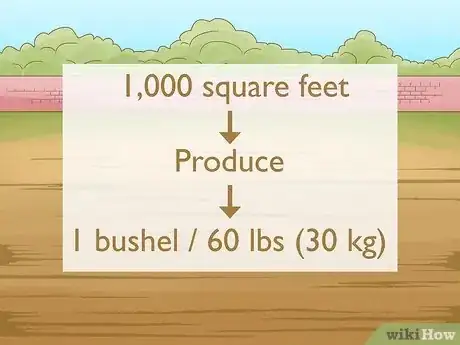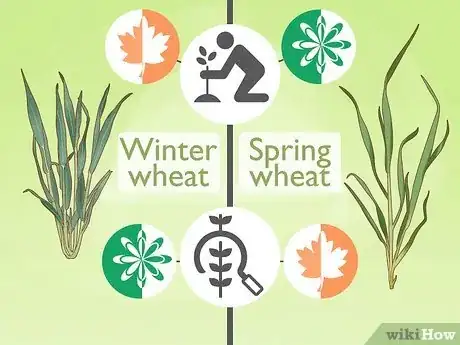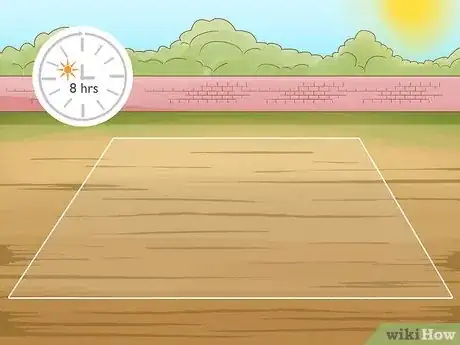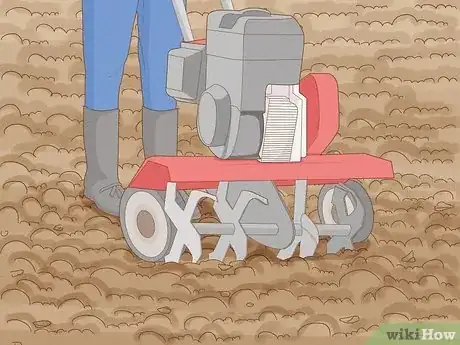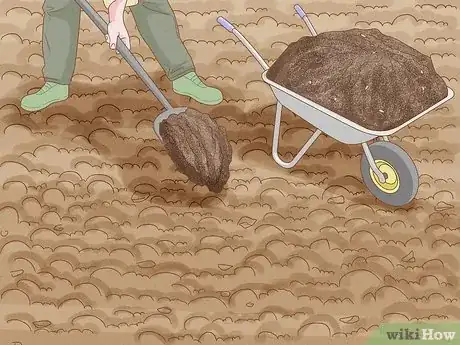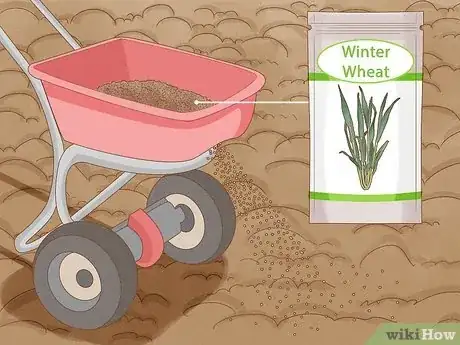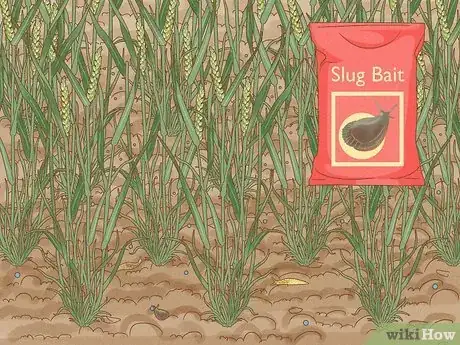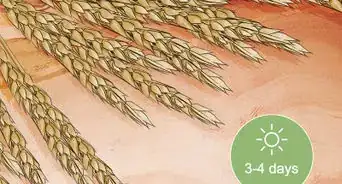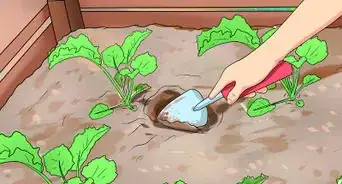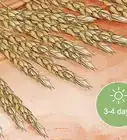This article was co-authored by Lauren Kurtz. Lauren Kurtz is a Naturalist and Horticultural Specialist. Lauren has worked for Aurora, Colorado managing the Water-Wise Garden at Aurora Municipal Center for the Water Conservation Department. She earned a BA in Environmental and Sustainability Studies from Western Michigan University in 2014.
wikiHow marks an article as reader-approved once it receives enough positive feedback. In this case, several readers have written to tell us that this article was helpful to them, earning it our reader-approved status.
This article has been viewed 256,694 times.
You don’t need a lot of space to plant wheat, but you do need to plan for the crop carefully. Planning and timing the planting of your crop gives it the best chance of flourishing. You also need to prepare the area where you’ll plant the wheat, and make sure it takes to the ground and grows well.
Steps
Planning Your Crop
-
1Determine how much space you have. About 1,000 square feet will yield one bushel, or 60 lbs (30 kg), of grain. That’s about the space of a backyard. You'll need to figure out how much wheat you want to grow and how much space it will take.[1]
-
2Determine the type of wheat you'll plant. Winter wheat is planted in the fall and harvested in early spring. It also tends to be the preferred variety since it is more nutritious and competes with fewer weeds in the spring. Spring wheat is planted in the spring and harvested in the fall. It is the more common variety in areas that have colder winters.Advertisement
-
3Choose your planting location. Your wheat should get plenty of sun while it grows, so make sure you plant it in full sun. The area where you plant should get about eight hours of sun a day. This is true whether you plant winter or spring wheat. Don't plan on planting your crop anywhere where there's too much shade.[2]
-
4Time your planting season. Prepare to plant winter wheat in the fall, approximately 6 to 8 weeks before the soil freezes, as this allows for strong root growth. Spring wheat can be planted as early as you can work the soil. Wheat grows best in 70 to 75 degree Fahrenheit ((21 to 24 degrees Celsius) weather, so you should plant your wheat when the weather is approaching that temperature (and eventually rising).
Planting Your Seeds
-
1Till your soil. You should till your soil to a depth of 6 inches (15 cm). You can use a rake, rototiller, or shovel to prepare the soil, although a rototiller is probably best if you're covering a large area. The ground needs to be as close to even as possible once you're finished, so you might need to run a rake over the top of the soil to even it out.[3]
-
2Spread compost if necessary. If your soil is overly dry (it will be a light brown color) or somewhat rocky, you might need a layer of compost. This provides the soil with extra nutrients and can help the wheat grow better. Soil that is a rich brown color and moist to the touch doesn't need any extra compost. [4]
-
3Spread your seeds. You can use your hand, but an actual seed spreader is best, because it gives you more even coverage. You should spread the seeds so that you have approximately one seed per 1 square inch (2.5 square centimeters) of space. The package of seeds should tell you how many pounds of seed you should use per 1,000 square feet of planting area, to give you a better idea of how much seed you need for large areas.[5]
-
4Rake the seeds. Once you’ve spread the seeds, they need to get worked into the soil. Using a metal rake, gently rake over the seeds so they get worked into the soil. Make sure you rake evenly so your crop doesn't come up in clumps.[6]
-
5Cover the seed with a thin layer of soil. This prevents the seed from drying out in the sun and from birds feeding on it. Cover spring wheat without about 1.5 inches (3.8 cm) of soil. Winter wheat should be 2.5 inches (6.4 cm) deep. The seed should never be covered by more than 3 inches (7.6 cm) of soil.
-
6Water your newly planted seeds. You should soak the area that’s planted right away. Keep the entire planting area moist until the wheat begins to grow. Cooler weather and more rain means less watering on your part.[7]
Maintaining Your Wheat
-
1Water your plants during dry spells. If your planting area goes through a dry spell - no rain for a week or so - you'll need to water the planting area. This will probably be more necessary if you're planting winter wheat than if you plant spring wheat.[8]
-
2Weed as needed. Wheat grows very close together, so you might not need to weed regularly. You should, however, keep an eye out for weeds, especially if it's your first time growing and you haven't spread your seeds evenly.[9]
-
3Protect your crop from pests. Slugs and insects like sawflies can destroy a crop of wheat. Slugs are likely to appear when the wheat is still very short, under 4 or 5 inches (9 to 10 cm). If you see them, use slug baits to keep them away from your wheat. If you notice sawflies, spray your crop with insecticide to protect the wheat.[10]
Expert Q&A
Did you know you can get expert answers for this article?
Unlock expert answers by supporting wikiHow
-
QuestionCan I plant wheat with fertilizer?
 Lauren KurtzLauren Kurtz is a Naturalist and Horticultural Specialist. Lauren has worked for Aurora, Colorado managing the Water-Wise Garden at Aurora Municipal Center for the Water Conservation Department. She earned a BA in Environmental and Sustainability Studies from Western Michigan University in 2014.
Lauren KurtzLauren Kurtz is a Naturalist and Horticultural Specialist. Lauren has worked for Aurora, Colorado managing the Water-Wise Garden at Aurora Municipal Center for the Water Conservation Department. She earned a BA in Environmental and Sustainability Studies from Western Michigan University in 2014.
Professional Gardener
-
QuestionIs it possible to grow wheat in a pot on a balcony if it is exposed to the sun?
 Lauren KurtzLauren Kurtz is a Naturalist and Horticultural Specialist. Lauren has worked for Aurora, Colorado managing the Water-Wise Garden at Aurora Municipal Center for the Water Conservation Department. She earned a BA in Environmental and Sustainability Studies from Western Michigan University in 2014.
Lauren KurtzLauren Kurtz is a Naturalist and Horticultural Specialist. Lauren has worked for Aurora, Colorado managing the Water-Wise Garden at Aurora Municipal Center for the Water Conservation Department. She earned a BA in Environmental and Sustainability Studies from Western Michigan University in 2014.
Professional Gardener
-
QuestionHow many tons of wheat should be expected from 1 hectare?
 Community AnswerYou can expect about 6,000 lbs of wheat from 1 hectare of planting area. This equals about 3 tons.
Community AnswerYou can expect about 6,000 lbs of wheat from 1 hectare of planting area. This equals about 3 tons.
Things You'll Need
- Rake, rototiller or shovel
- Fertilizer
- Wheat seeds
- Seed drill
- Water
- Protected Area
References
- ↑ http://modernfarmer.com/2015/08/how-to-grow-and-harvest-grains-in-your-backyard/
- ↑ http://modernfarmer.com/2015/08/how-to-grow-and-harvest-grains-in-your-backyard/
- ↑ http://modernfarmer.com/2015/08/how-to-grow-and-harvest-grains-in-your-backyard/
- ↑ http://modernfarmer.com/2015/08/how-to-grow-and-harvest-grains-in-your-backyard/
- ↑ http://www.gardeningblog.net/how-to-grow/wheat/
- ↑ http://modernfarmer.com/2015/08/how-to-grow-and-harvest-grains-in-your-backyard/
- ↑ http://modernfarmer.com/2015/08/how-to-grow-and-harvest-grains-in-your-backyard/
- ↑ http://www.gardeningblog.net/how-to-grow/wheat/
- ↑ http://www.gardeningblog.net/how-to-grow/wheat/
About This Article
To plant wheat, start by tilling your soil to a depth of 6 inches with a rake, shovel or rototiller. If the soil looks dry, spread a layer of compost over it. Then, scatter your seeds evenly so that they are roughly 1 square inch apart. Rake the seeds gently so they go into the soil, which prevents them from being eaten by birds. After planting, you should water the entire area and repeat the process if you have a dry spell of over a week. For tips from our Horticulturist reviewer on how to choose between winter wheat and summer wheat, and how to keep pests off your crop, read on!
